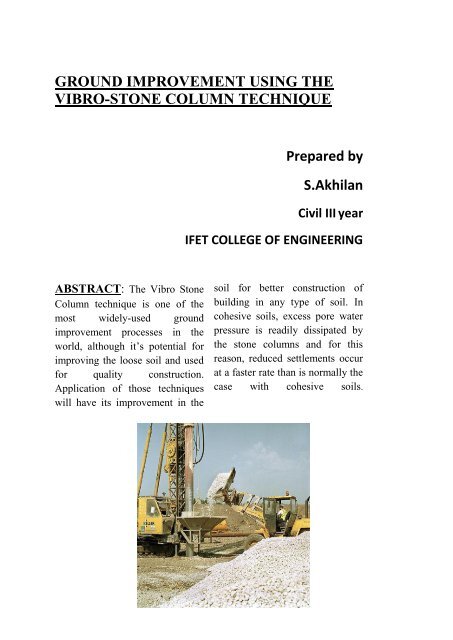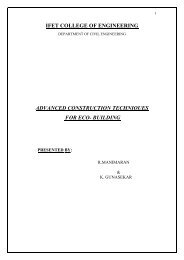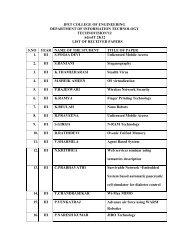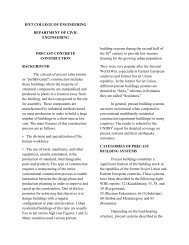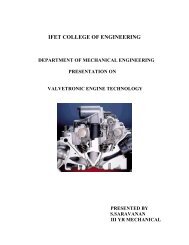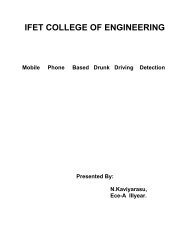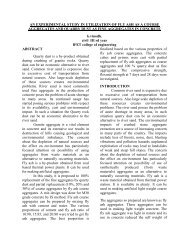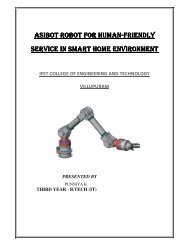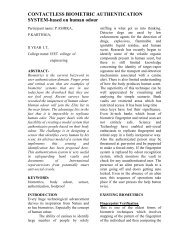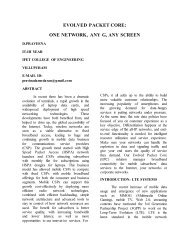GROUND IMPROVEMENT USING THE VIBRO-STONE COLUMN ...
GROUND IMPROVEMENT USING THE VIBRO-STONE COLUMN ...
GROUND IMPROVEMENT USING THE VIBRO-STONE COLUMN ...
Create successful ePaper yourself
Turn your PDF publications into a flip-book with our unique Google optimized e-Paper software.
<strong>GROUND</strong> <strong>IMPROVEMENT</strong> <strong>USING</strong> <strong>THE</strong><br />
<strong>VIBRO</strong>-<strong>STONE</strong> <strong>COLUMN</strong> TECHNIQUE<br />
Prepared by<br />
S.Akhilan<br />
Civil III year<br />
IFET COLLEGE OF ENGINEERING<br />
ABSTRACT: The Vibro Stone<br />
Column technique is one of the<br />
most widely-used ground<br />
improvement processes in the<br />
world, although it’s potential for<br />
improving the loose soil and used<br />
for quality construction.<br />
Application of those techniques<br />
will have its improvement in the<br />
soil for better construction of<br />
building in any type of soil. In<br />
cohesive soils, excess pore water<br />
pressure is readily dissipated by<br />
the stone columns and for this<br />
reason, reduced settlements occur<br />
at a faster rate than is normally the<br />
case with cohesive soils.
INTRODUCTION<br />
Vibro-Flotation is a collective term<br />
for forms of ground improvement<br />
brought about by inserting a<br />
vibrating poker into the ground, and<br />
includes Vibro-Compaction and<br />
Vibro-Replacement. The stone<br />
columns and intervening soil form<br />
and integrated foundation support<br />
system having low compressibility<br />
and improved load bearing capacity.<br />
In cohesive soils, excess pore water<br />
pressure is readily dissipated by the<br />
stone columns and for this reason,<br />
reduced settlements occur at a faster<br />
rate than is normally the case with<br />
cohesive soils.<br />
<strong>VIBRO</strong>-COMPACTION<br />
AND<br />
<strong>VIBRO</strong>REPLACEMENT<br />
Vibro-Flotation is performed with a<br />
vibrating poker device which can<br />
penetrate to the required treatment<br />
depth under the action of its own<br />
vibrations, assisted by the pull-down<br />
winch facility of the rig. The<br />
vibrations imparted to the ground are<br />
predominantly horizontal and will<br />
increase the relative density of soil if<br />
the granular content is greater than<br />
≈90% (see Figure 1). This process is<br />
referred to as Vibro-Compaction,<br />
and has been used to compact loose<br />
sands to depths of 30m, such as in<br />
The World and Palm Island Projects<br />
off the Dubai coast and Edinburgh’s<br />
Leith Docks.<br />
However, the vibrations themselves<br />
have minimal effect on cohesive<br />
soils (clays and silts), so in these and<br />
mixed soils, the penetration of the<br />
poker is followed by the<br />
construction of a stone column. The<br />
displacement of the existing ground<br />
by the penetrating poker allows the<br />
construction of granular columns<br />
with high friction angle, so that the<br />
composite soil mass has a greater<br />
average strength and stiffness than<br />
the untreated ground.<br />
The hole created by the poker is<br />
filled with inert crushed stone or<br />
gravel (or approved construction<br />
waste in certain circumstances) and<br />
is compacted in stages from the base<br />
of the hole upwards. There are two<br />
different approaches that may be<br />
used to construct the column,<br />
depending on the ground conditions.<br />
In the Top Feed System, the poker is<br />
completely withdrawn after initial<br />
penetration to the design depth.<br />
Stone (40-75mm in size) is then<br />
tipped into the hole in controlled<br />
volumes from the ground surface.<br />
The column is compacted in layers<br />
(the stone is forced downwards and<br />
outwards) through continued<br />
penetration and withdrawal of the<br />
poker. The Top Feed System is<br />
suitable if the hole formed by the<br />
poker will remain open during<br />
construction of the column.<br />
Alternatively, the stone may be fed<br />
from a rig-mounted hopper through<br />
a permanent delivery tube along the<br />
side of the poker, which bends<br />
inwards and allows the stone to exit<br />
at the poker tip. This Bottom Feed<br />
process requires a smaller grade of<br />
stone (15-45mm). By remaining in<br />
the ground during column
construction, the poker cases its own<br />
hole and hence is suited to ground<br />
with a high water table or running<br />
sand conditions. The Bottom Feed<br />
system is shown on the cover<br />
photograph, with a schematic<br />
illustration of the process shown in<br />
Figure 2.<br />
In addition to improving bearing<br />
capacity and reducing<br />
compressibility, stone columns<br />
installed in a uniform grid pattern<br />
will help ‘homogenise’ variable soil<br />
properties, thereby reducing the<br />
potential for differential settlement.<br />
Stone columns serve a secondary<br />
function of acting as vertical drains,<br />
accelerating the dissipation of excess<br />
pore water pressures (and associated<br />
primary settlement) from the<br />
imposed loading, allowing a<br />
foundation or floor slab to be<br />
brought into service at an early<br />
stage. In addition to the savings per<br />
metre length that stone columns<br />
present over piles, the ‘soft’ column<br />
heads facilitate the use of ground<br />
bearing slabs, representing further<br />
savings compared to the ground<br />
beams and suspended slabs<br />
associated with piled solutions.<br />
Plate load tests (typically 600mm<br />
diameter) are carried out on<br />
constructed columns to verify the<br />
compactness of the stone and the<br />
stiffness of the supporting ground at<br />
the top of the column. However,<br />
settlements measured may not be<br />
representative of foundation or slab<br />
behaviour due to differences in the<br />
load duration and depth to which the<br />
ground is stressed. Long term zone<br />
load tests provide a truer reflection<br />
of the stiffness of the ground, as a<br />
plan area the size of a real<br />
foundation is loaded which will<br />
usually straddle several columns and<br />
the intervening untreated ground.<br />
However, due to their cost, these are<br />
generally reserved for marginal sites.<br />
In addition to these control<br />
measures, it should be noted that the<br />
vibrating poker itself acts as an<br />
investigating tool which provides an<br />
additional safeguard against<br />
unforeseen ground conditions. A<br />
measure of the resistance to<br />
penetration of the poker is fed back<br />
electronically to the rig operator,<br />
who can then match the quantity of<br />
stone supplied to the lateral<br />
resistance of the ground<br />
encountered.<br />
Key publications which illustrate the<br />
Vibro-Compaction and Replacement<br />
techniques, the importance of good<br />
construction practice and some<br />
interesting case histories are<br />
Slocombe et al (2000), Bell (2004)<br />
and Sondermann and Wehr (2004).<br />
BEHAVIOUR AND DESIGN<br />
OF <strong>STONE</strong> <strong>COLUMN</strong>S<br />
most types of ground improvement<br />
are intended to work with the<br />
existing ground whereas rigid<br />
inclusions (piles) are intended to<br />
bypass the ground to some extent.<br />
While stone columns will transmit<br />
some load to the soil by shear<br />
stresses (along the column-soil<br />
interface) and end bearing (at the<br />
column base), the predominant loadtransfer<br />
mechanism (unless the<br />
column is very short) is lateral<br />
bulging into the surrounding soil.<br />
The relevant column stresses are<br />
depicted in Figure 3, while Figure 4<br />
illustrates the bulging phenomenon
in model granular column tests in<br />
clay carried out at the University of<br />
Plymouth. The passive resistance of<br />
the surrounding soil dictates the<br />
column performance under load.<br />
Generally the column bulging will<br />
be greatest close to the top of the<br />
column where the overburden<br />
pressures are lowest.<br />
Cylindrical Cavity Expansion<br />
Theory (CCET) is applied to many<br />
geotechnical problems, most notably<br />
to the interpretation of the<br />
pressuremeter test which measures<br />
horizontal stresses in the ground (i.e.<br />
Wroth, 1984). CCET has also been<br />
used to model the bulging behaviour<br />
of granular columns leading to<br />
predictions of bearing capacity and<br />
settlement performance.<br />
Bearing Capacity<br />
Hughes and Withers (1974)<br />
performed pioneering laboratory<br />
studies of sand columns within a<br />
cylindrical chamber containing clay,<br />
and used radiography to track the<br />
deformations occurring within and<br />
outside the column. They found that<br />
CCET represented the measured<br />
column behaviour very well, and<br />
proposed that the ultimate vertical<br />
stress (q) in a stone column could be<br />
predicted by:<br />
where φ’ is the friction angle of the<br />
stone infill, σ' ro<br />
is the free-field<br />
lateral effective stress and c is the<br />
column and A = total cross-sectional<br />
area of the ‘unit cell’ attributed to<br />
each column (see Figure 5). A c<br />
/A is<br />
related geometrically to the column<br />
radius (r) and column spacing (s)<br />
according to:<br />
undrained strength. This equation is<br />
widely used in practice today.<br />
There are alternative approaches for<br />
estimating the bearing capacity of<br />
single columns and column groups,<br />
such as that recently published by<br />
Etezad et al (2006). The authors<br />
report an analytical treatment of<br />
bearing capacity failure mechanisms.<br />
The failure mechanisms adopted are<br />
based upon the output from a<br />
combination of Finite Element<br />
analyses and field trials.<br />
Settlement<br />
Absolute and differential settlement<br />
restrictions usually govern the length<br />
and spacing of columns, and the<br />
preferred method of estimating posttreatment<br />
settlement in European<br />
practice was developed by Priebe<br />
(1995), again based upon CCET.<br />
Although this method is strictly<br />
applicable to an infinite array of<br />
columns and has some empiricism in<br />
its development, it is found to work<br />
very well for most applications.<br />
Priebe’s settlement improvement<br />
factor, n, defined as:<br />
treatmentwithsettlementtreatmentwit<br />
houtsettlementn= [2]<br />
is a function of the friction angle of<br />
the stone φ’, the soil’s Poisson’s<br />
ratio and an Area Replacement Ratio<br />
dictated by the column spacing. The<br />
area replacement ratio is defined as<br />
A c<br />
/A, where A c<br />
= cross-sectional<br />
area of one<br />
2⎟⎠⎞⎜⎝⎛=srkAAc [3]<br />
where k is π and 2π/√3 for square<br />
and triangular column grids<br />
respectively. Beneath footings and<br />
strips, it is usually sufficient to<br />
determine A c<br />
directly as the total
foundation area divided by the<br />
number of supporting columns.<br />
Priebe’s ‘basic improvement factor’<br />
may be derived from the chart<br />
shown in Figure 6 (note the<br />
reciprocal Area Replacement Ratio<br />
A/A c<br />
is used). However, corrections<br />
should be applied to allow for the<br />
compressibility of the column<br />
aggregate and influence of the<br />
pressure gradient along the soilcolumn<br />
interface; features not<br />
catered for in earlier work (Priebe<br />
1976).<br />
The method of Baumann and Bauer<br />
(1974) is sometimes used in Europe,<br />
although it has a weaker theoretical<br />
basis than Priebe (1995) and is<br />
believed to give poorer settlement<br />
predictions for clayey soils<br />
(Slocombe, 2001). The approach of<br />
Goughnour and Bayuk (1979) is<br />
preferred in the United States,<br />
although the method is much more<br />
complex and the necessary<br />
parameters are not readily available<br />
from routine Ground Investigations.<br />
With the continued development of<br />
more realistic constitutive soil<br />
models, designated geotechnical<br />
Finite Element (FE) software (and 2-<br />
D PLAXIS in particular) is being<br />
used to model stone column<br />
foundations (i.e. Debats et al 2003,<br />
Wehr and Herle 2006). The FE<br />
method has the particular advantage<br />
of allowing the ground improvement<br />
scheme to be modelled in unison<br />
with the slab or foundation it<br />
supports. It is also very useful for<br />
unusual situations for which no<br />
standard design method exists, such<br />
as the composite pile/ground<br />
improvement used to support raft<br />
foundations at Limehouse Basin in<br />
London. Here Continuous Flight<br />
Augered (CFA) Piles were<br />
constructed to within ≈3m of the<br />
ground surface. Stone columns were<br />
constructed from the top of the CFA<br />
piles to the ground surface to<br />
reinforce and even out variable<br />
made ground conditions.<br />
SOFT OR MARGINAL<br />
<strong>GROUND</strong> CONDITIONS<br />
The construction industry has been<br />
buoyant in Ireland over the past 5-10<br />
years, and with the ever increasing<br />
pressure to develop marginal sites,<br />
there is considerable interest in the<br />
applicability of stone columns to<br />
cohesive and organic soils. The<br />
following checklist may be useful if<br />
contemplating a Stone Column<br />
ground improvement solution:<br />
(i) Organic soils are characterised by<br />
high moisture content, plasticity<br />
index and compressibility and as a<br />
general rule, the higher the organic<br />
content, the more difficult it is to<br />
arrest settlement in these soils. Most<br />
organic silts and clays may be<br />
successfully treated. If present in a<br />
discrete layer less than ≈0.6m thick,<br />
a stone column may be formed in<br />
peat. However, for larger layer<br />
thicknesses or multiple thin bands, it<br />
is unlikely that the peat will provide<br />
adequate passive resistance to<br />
confine the column (Mitchell and<br />
Jardine 2002). It may be possible to<br />
install a dry plug of lean-mix<br />
concrete to bridge a compressible<br />
peat layer which is in excess of 0.6m<br />
in thickness, and this may be<br />
installed during the stone column
construction process. Geogrids and<br />
geotextiles installed around the<br />
column’s perimeter have also been<br />
used to confine columns through<br />
weaker strata.<br />
(ii) A lower limit to the undrained<br />
strength of c u<br />
=15kPa is suggested<br />
for treatment with stone columns,<br />
although there have been situations<br />
where softer soils have been<br />
successfully improved (Raju et al,<br />
2004, and others). However it is not<br />
sufficient to consider the<br />
undisturbed strength of cohesive soil<br />
alone; the sensitivity of the soil to<br />
disturbance (S t<br />
) is equally important:<br />
remouldedudundisturbeutccS<br />
= [4]<br />
where c u remoulded<br />
is the undrained<br />
strength of soil with its natural<br />
structure destroyed. Normally<br />
consolidated clays are more likely to<br />
be sensitive than overconsolidated<br />
clays, and while most clays have S t<br />
values between 1 and 4, S t<br />
may be as<br />
high as 150 in the case of the well<br />
publicized Scandanavian and<br />
Canadian quick clays. Vibrations<br />
from a depth vibrator can lead to a<br />
considerable loss of strength in very<br />
sensitive soils, which can impact<br />
upon the trafficability of sites,<br />
adjacent structures and slope<br />
stability. Fortunately, Ireland has<br />
few soils in the very sensitive<br />
category.<br />
(iii) Plasticity Index: The plasticity<br />
index (I p<br />
) of a soil reflects the<br />
potential for volume change;<br />
swelling and shrinkage will not be<br />
controlled by adding stone columns.<br />
Although the UK National House<br />
Building Council (NHBC, 1988)<br />
suggests that stone columns should<br />
not be used when I p<br />
>40%, high<br />
plasticity soils can still be improved<br />
by stone columns in certain<br />
circumstances.<br />
(iv) Clay Fill: The self-weight<br />
settlement of recent clay fills (or<br />
mixed fills containing substantial<br />
clay) may be difficult to predict,<br />
especially if there has been little<br />
control in placement. While<br />
installation of stone columns<br />
through such fill may accelerate the<br />
settlement process, the magnitude of<br />
settlement will not be reduced. It is<br />
generally adopted practice, from<br />
extensive experience, that columns<br />
should not be used in clay fill which<br />
is less than 10 years in place.<br />
Stone columns are of little benefit in<br />
loose fills which are susceptible to<br />
collapse settlement (such as may be<br />
present in back-filled quarry pits).<br />
Collapse settlement may arise from<br />
first-time inundation of water<br />
directly through the ground surface,<br />
from underneath the ground surface<br />
(such as a leaking pipe) or from a<br />
rising groundwater table. Stone<br />
columns may facilitate the passage<br />
of water unless suitable precautions<br />
are taken. Sudden settlement of the<br />
fill would lead to an instant loss of<br />
lateral support at the top of the<br />
column (Mitchell and Jardine,<br />
2002).<br />
RECENT <strong>STONE</strong> <strong>COLUMN</strong><br />
RESEARCH<br />
Recent innovative and high quality<br />
model tests carried out at the
University of Glasgow (Muir Wood<br />
et al, 2000) and Queens University<br />
Belfast (McKelvey et al, 2004,<br />
Black et al, 2006) have improved<br />
our understanding of stone column<br />
behaviour. Details of the apparatus<br />
and procedures used may be found<br />
in the relevant references, but a<br />
summary of the main practical<br />
findings is provided here.<br />
Muir Wood et al. (2000) conducted<br />
what is considered to be the most<br />
comprehensive laboratory model<br />
investigations of large groups of<br />
columns. The results suggest that the<br />
pre-failure mechanisms and failure<br />
modes of column groups are<br />
different from those of an isolated<br />
column. It was reported that the area<br />
replacement ratio (A c<br />
/A) influences<br />
the extent of column interaction and<br />
the load sharing between the<br />
columns and intervening ground.<br />
The research also claims that<br />
significant improvement to bearing<br />
capacity requires an area<br />
replacement ratio of ≈25% or<br />
greater.<br />
Perhaps the most fundamental aspect<br />
of this work was the postulation of a<br />
realistic group failure mechanism.<br />
The deformation patterns in the<br />
columns were observed upon<br />
excavating the ground around the<br />
loaded columns. Columns adjacent<br />
to the centre column exhibited the<br />
most distortion. This observation is<br />
in good agreement with the stress<br />
levels measured at this location.<br />
Most of the bulging, shearing and<br />
lateral deflection occurred within a<br />
‘conical’ region directly beneath the<br />
foundation. The depth of this failure<br />
wedge increased as the area<br />
replacement ratio increased.<br />
A four-part failure mechanism was<br />
proposed based upon these<br />
observations (Figure 7). A conical<br />
zone (Zone 1) exists immediately<br />
beneath the footing in which there is<br />
no column deformation as the clay<br />
itself and confinement of the rigid<br />
footing provide adequate passive<br />
resistance. In Zone 2 (which is<br />
immediately below Zone 1),<br />
deformations are plastic and column<br />
bulging, shearing and buckling of<br />
the columns were all observed. Zone<br />
3 is referred to as the ‘retaining unit’<br />
which effectively provides lateral<br />
support to the failure wedge<br />
underneath the footing. Zone 4<br />
represents the ‘extension’ zone of<br />
the mechanism.<br />
McKelvey et al (2004) used a<br />
transparent medium with ‘clay-like’<br />
properties to allow visual monitoring<br />
of the columns throughout<br />
foundation loading. The main<br />
findings of this research relate to<br />
optimum column aspect ratio L/d (L<br />
=column length, d =column<br />
diameter).<br />
Careful examination of the digital<br />
images taken during loading (Figure<br />
8) showed that in the case of ‘short’<br />
columns (i.e. L/d = 6), bulging took<br />
place over the entire length of the<br />
columns and they punched into the<br />
clay beneath their bases. The ‘long’<br />
column (L/d = 10) deformed<br />
significantly in the upper region<br />
whereas the bottom portion<br />
remained undeformed. This suggests<br />
that there was little or no load<br />
transfer to the base in longer
columns, with failure arising from<br />
bulging or shear. McKelvey et al<br />
(2004) postulated a ‘critical column<br />
length’ of L=6d, which is in keeping<br />
with earlier work (Hughes and<br />
Withers, 1974, Muir Wood et al<br />
2000).<br />
Black et al (2006) developed a more<br />
sophisticated triaxial apparatus in<br />
which the boundary conditions<br />
imposed on a clay bed (reinforced<br />
with stone columns) can be<br />
regulated. Publication of this work is<br />
pending at the time of writing.<br />
The Finite Element method has been<br />
used in some academic studies, most<br />
using the homogenisation technique<br />
(i.e. Lee and Pande, 1998) in which<br />
the constitutive models are<br />
developed from composite soil<br />
properties assigned to the entire<br />
reinforced zone. However, the FE<br />
Method’s potential to address some<br />
of the key shortcomings in stone<br />
column design has not been<br />
harnessed. Collaborative research<br />
between NUI Galway’s Civil<br />
Engineering Department and Keller<br />
Ground Engineering aims to use the<br />
FE Method in an applied sense to<br />
address issues such as:<br />
(i) the behaviour of floating columns<br />
(or partial depth treatment); Priebe’s<br />
(1995) formulation assumes that<br />
columns are terminated at a rigid<br />
layer, and<br />
(ii) the extent to which stone<br />
columns arrest secondary or creep<br />
settlement, which is most prevalent<br />
in organic soils.<br />
CASE HISTORY<br />
RetirementVillage,<br />
Ballinasloe, Co. Galway<br />
At the time of writing, a new<br />
retirement village is under<br />
construction on the banks of the<br />
River Suck in Ballinasloe. The<br />
development comprises a two-storey<br />
nursing home and a four-storey<br />
apartment block, with site levels<br />
raised by 1-1.5m for flood<br />
protection. Ground conditions at the<br />
site are mixed but typically comprise<br />
of up to 1.5m of soft organic fill<br />
overlying medium dense and dense<br />
silty sandy gravel with occasional<br />
cobbles and boulders.<br />
Rather than piling to depth to<br />
support the four-storey block, a<br />
ground improvement solution was<br />
implemented whereby the soft<br />
organic fill was removed and<br />
replaced with clean stone (
change of poker. A further<br />
description of the VCC technique<br />
may be found in McCabe and<br />
McNeill (2006). It is not uncommon<br />
to use a suitable combination of<br />
Vibro Stone Columns and VCCs at<br />
one site.<br />
CONCLUSIONS<br />
The Irish construction industry has<br />
been slower than many of its<br />
European counterparts to recognise<br />
the technical and economic<br />
advantages that Vibro Stone<br />
Columns can provide. Ireland has an<br />
Mechanisms of load transfer for<br />
(a) a rigid pile and (b) a stone<br />
column (after Hughes and Withers<br />
1974)<br />
Model tests on stone column<br />
showing characteristic bulging<br />
behaviour<br />
abundance of soft estuarine and<br />
alluvial soils and these may be<br />
improved sufficiently to allow<br />
standard foundations to be<br />
constructed at shallow depth,<br />
without the need to resort to deep<br />
piling.<br />
Where ground conditions are<br />
suitable, stone column solutions<br />
have been shown to be more cost<br />
effective than trench fill in excess of<br />
2m depth. In addition, stone<br />
columns can offer considerable<br />
contract programme savings over<br />
other ground improvement methods,<br />
such as preloading and vertical<br />
drains.<br />
As with all geotechnical projects, a<br />
thorough site investigation with<br />
adequate information on soil<br />
strength and compressibility is<br />
essential.
REFERENCES<br />
Baumann, V. and Bauer, G.E.A.<br />
(1974) The performance of<br />
foundations on various soils<br />
stabilized by the Vibro-Compaction<br />
Method, Canadian Geotechnical<br />
Journal, Vol. 11, No. 4, pp 509-530.<br />
Bell, A.L. (2004) The development<br />
and importance of construction<br />
technique in deep vibratory ground<br />
improvement, Proc. Ground and<br />
Soil Improvement, Geotechnique<br />
Symposium, edited by C.A. Raison,<br />
pp 103-111.<br />
Black, J.A., Sivakumar, V., Madhav,<br />
M.R. and McCabe, B.A. (2006) An<br />
improved experimental test set-up to<br />
study the behaviour of granular<br />
columns, Geotechnical Testing<br />
Journal, ASTM, Vol. 29, No. 3, pp<br />
193-199.<br />
Debats, J.M., Guetif, Z. and<br />
Bouassida, M.(2003). Soft soil<br />
improvement due to vibrocompacted<br />
columns installation.<br />
Proceedings of the International<br />
Workshop on Geotechnics of Soft-<br />
Soils-Theory and Practice, pp 551-<br />
556.<br />
Etezad, M., Hanna, A.M. and<br />
Ayadat. T. (2006) Bearing capacity<br />
of groups of stone columns,<br />
Proceedings of the 6 th<br />
European<br />
Conference on Numerical Methods<br />
in Geotechnical Engineering, Graz,<br />
pp. 781-786.<br />
Figure 8: Photographs of sand<br />
columns beneath circular footing,<br />
before,<br />
during and after loading (a) L/d=6,<br />
(b) L/d=10, (McKelvey et al, 2004)


